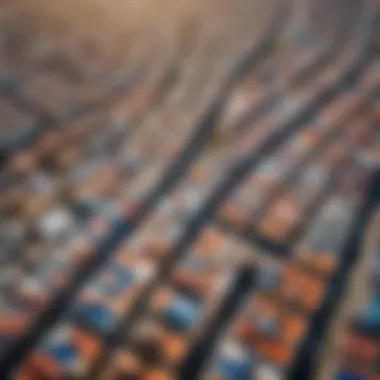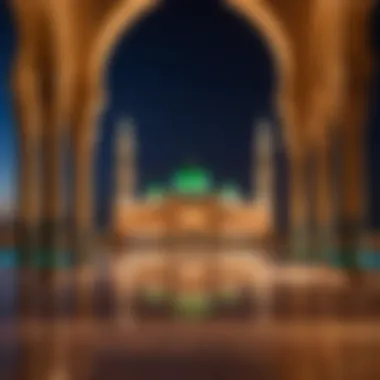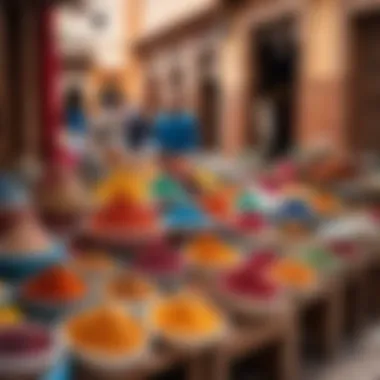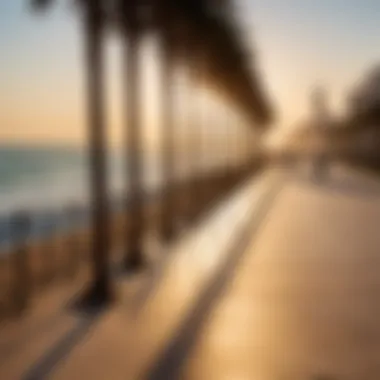Casablanca: Insights into Culture and Economy


Intro
Casablanca, a city that stands as a cornerstone of Morocco's economy and culture, is often regarded as a cultural melting pot. Its history is a tapestry woven with local traditions and foreign influences. This guide aims to unravel the multifaceted identity of Casablanca by investigating its geography, culture, and historical significance.
The city is not merely a tourist destination; it embodies a complex socio-economic landscape. Travelers and curious minds seeking to comprehend its layers will find that Casablanca offers both richness and depth. This journey through the city’s attractions, traditions, and economic role sets the stage for a broader understanding of what makes Casablanca a significant hub in the region.
Популярные направления
Уникальные направления для экзотических путешествий
For those seeking unique travel experiences, Casablanca presents an unexpected blend of modernity and tradition. The Hassan II Mosque is a prime example. As one of the largest mosques in the world, it not only serves as a religious site but also as an architectural landmark, attracting visitors due to its exquisite design and coastal location.
Exploring the Old Medina reveals a different side of the city. The narrow streets hide a vibrant local market showcasing crafts and culinary delights. Visitors can indulge in flavorful Moroccan dishes while immersing themselves in daily life within the walls of this historic district.
Another noteworthy destination is the Royal Palace of Casablanca. Although the royal family only occasionally occupies the palace, its stunning architecture and surrounding gardens offer a tranquil escape from the city’s bustle.
Casablanca stands at the intersection of tradition and modernity, making it a must-visit for discerning travelers.
Комфортные места для семейного отдыха
Families visiting the city will find several comfortable spots that cater to various interests. The Morocco Mall, for instance, is not just a shopping center; it combines entertainment with retail, featuring an aquarium, IMAX theater, and numerous dining options. Children can marvel at the sea life while adults indulge in shopping.
Parc de la Ligue Arabe is another excellent choice for families. This large urban park offers ample space for relaxation, playgrounds for kids, and picturesque walking paths. It serves as an ideal location for a leisurely family afternoon, free from the city's hectic pace.
Подготовка к путешествию
Советы по выбору маршрута
Selecting the right itinerary can significantly enhance the travel experience. Evaluate personal interests—whether it’s history, food, or architecture—and plan accordingly. It may be beneficial to include core attractions like the Hassan II Mosque and the Royal Palace, but also consider allocating time for off-the-beaten-path locations to gain a deeper understanding of local life.
Как собрать чемодан: полезные советы
Packing wisely is essential for a comfortable trip. Visitors should consider the local climate, which is generally mild, and opt for layers that can be easily adjusted. Comfortable walking shoes are necessary for exploring the city’s attractions. Don’t forget a reusable water bottle and a small bag for any purchases made while exploring the local markets.
Prelims to Casablanca
Casablanca is not just a city; it embodies a unique blend of history, culture, and economy, making it a focal point in Morocco. Understanding Casablanca is crucial for anyone interested in exploring its past and present. This introduction sets the stage for a deeper dive into the key elements that shape the city.
The significance of this topic lies in the way it reveals Moroccan identity through Casablanca's narratives. A diverse population, a mix of traditions, and colonial influences speak of a complex social fabric. Each aspect contributes to the city's character and its role as a major tourist destination.
When considering a visit to Casablanca, one should note the essentials: its historical landmarks, vibrant markets, and lively street life. Knowledge of the city's context enhances travel experiences. Travelers can interact more meaningfully with locals and partake in cultural activities.
Additionally, being informed about Casablanca's economic landscape is important. The city is a hub for various industries, including textiles, automotive, and aeronautics. This growth shapes the local culture and offers insights into modern Moroccan life.
In this article, we will break down the geographical, historical, and cultural dimensions of Casablanca. This exploration will offer valuable insights for travelers, ensuring they appreciate not just the sights but the stories behind them.
"Casablanca is a city that plays a vital role in shaping not only Morocco but also the broader narrative of North Africa."
By understanding the significance of each component discussed throughout this article, readers will gain a comprehensive grasp of Casablanca's multifaceted identity. It will prepare them for a meaningful journey through this vibrant city.
Geographical Location of Casablanca
Casablanca's geographical location is significant for understanding its role as one of Morocco's key cities. The city is situated on the western coast of Morocco, along the Atlantic Ocean. This coastal position not only grants the city a strategic advantage in terms of trade but also influences its cultural exchange and tourism.


Coordinates and Map Overview
Casablanca lies at the coordinates 33.5731° N latitude and 7.5898° W longitude. Its location makes it the largest city in Morocco and the economic heart of the country. On a map, Casablanca can be identified roughly in the middle of Morocco's Atlantic coastline. Its proximity to other major cities such as Rabat, the capital, and Marrakesh makes it easily accessible for travelers. The map highlights Casablanca’s status as a port city, which historically has been vital for maritime trade routes.
"Casablanca serves as a bridge between traditional Moroccan heritage and modern advancements, making it a focal point in the region."
Climate and Weather Patterns
The climate in Casablanca is characteristic of a Mediterranean climate with mild, wet winters and warm, dry summers. The average temperature ranges from 10°C (50°F) in January to 30°C (86°F) in July. This climate is essential for agriculture, tourism, and the lifestyle of the locals. The city receives a considerable amount of rainfall from October to April, which contributes to the lush greenery surrounding it. In contrast, the summer season is dry and attracts numerous tourists looking to enjoy the beaches and outdoor activities.
The weather in Casablanca is generally pleasant and moderate, making it an attractive destination year-round. Travelers considering a visit will find that the most desirable time to explore the city is during spring and autumn when the temperatures are comfortable and the tourist crowds are smaller.
Historical Context of Casablanca
Understanding the historical context of Casablanca is essential for grasping its evolution as a central hub in Morocco. This section outlines the forming moments and influences that shaped the city, providing insights into its current identity and significance.
Founding and Early Developments
Casablanca’s origins trace back to the Berber settlements before the arrival of the Phoenicians in the 7th century. The name "Casablanca" itself is derived from the Spanish term, meaning "White House," which is attributed to the white-washed structures echoed through the city. Around the 18th century, the modern growth of Casablanca began when Sultan Mohammed ben Abdallah sought to develop a port for trade. This strategic decision laid the groundwork for the city's future as a bustling maritime center. By the 19th century, Casablanca emerged as a hub of commerce, connecting Morocco with European markets.
Colonial Influence
The advent of French colonial rule in the early 20th century brought significant changes to Casablanca. Established as a protectorate in 1912, the French reshaped the city’s infrastructure, contributing to its rapid modernization. Land reclamation projects expanded the port further, turning it into one of the busiest ports in Africa. In this period, the city saw the construction of European-style architecture, which distinguished the modern urban landscape from the historic Medina. Increased migration from rural areas fueled a diverse population, embedding various cultural influences.
This colonial era was marked by both advancement and tension, as social dynamics shifted and nationalist movements began to rise. Wealth concentrated in certain sectors of society, leading to economic disparity that has continued to affect the city to this day.
Post-Independence Era
With Morocco’s independence in 1956, Casablanca faced the challenge of redefining itself. The city became central to Morocco’s identity as a sovereign nation. Nationalist sentiments flooded the streets, and efforts were made to reclaim and repurpose the colonial infrastructure for the needs of a growing population.
In the decades since independence, Casablanca has maintained its status as Morocco’s economic engine, emphasizing industrial growth and modernization. The development of the Casablanca Finance City in the 2010s exemplifies the focus on financial services, enhancing its pull on global investments.
Today, Casablanca stands as a vibrant city that reflects its rich, complex history, balancing its colonial past with aspirations for the future. It highlights Morocco's journey of transformation, symbolizing resilience and adaptation in the face of change.
Cultural Significance
The cultural significance of Casablanca extends far beyond its geographical location. It is a melting pot of tradition and modernity, embodying a blend of influences from various periods and peoples. Casablanca serves as a crucial center for understanding Moroccan identity, expressed through its diverse communities and rich traditions. This section examines the dynamics of the city's populace and the vibrant cultural events that characterize its social life.
Diverse Population and Communities
Casablanca is home to a remarkably diverse population, with people from various ethnic and social backgrounds. The city has a mix of Arab, Berber, and other cultures, creating a rich tapestry that showcases Morocco's multiracial history. This diversity is evident in the different neighborhoods, each with its unique characteristics and communal activities.
The Habous district, known for its traditional architecture and markets, reflects the historical essence of the city. Meanwhile, areas like the Maarif district highlight modern influences, catering primarily to the younger demographic with contemporary shops and cafes.
Understanding this variety of communities allows travelers to immerse themselves in authentic local experiences. Engaging with the locals, sampling regional cuisine, and participating in community events offer insights into the social fabric that defines Casablanca. Every interaction opens doors to learning about daily life, customs, and the harmonious blend of traditional and modern influences.
Traditions and Festivals
Casablanca's traditions and festivals play a critical role in preserving its cultural identity. Various celebrations throughout the year showcase the city's vibrant heritage. Notable festivals include the Festival de Casablanca, which celebrates music and the arts, drawing artists and visitors from all over the world. This event is a testament to the city's enduring love for art and expression.
The Eid al-Fitr and Eid al-Adha, two paramount Islamic holidays, see the city come alive with communal prayers and feasts. Families gather, homes are decorated, and the streets are filled with joy and colorful displays. These acts not only reinforce religious observance but also encourage a sense of unity among the residents.
These cultural traditions are essential to understanding Casablanca's identity. They provide travelers with a glimpse into the city's soul and the values held dear by its citizens. Engaging with these traditions fosters respect and appreciation for the local way of life, encouraging a connection that transcends mere tourism.
"Cultural exchanges in Casablanca foster understanding and respect among diverse populations, enriching the city’s social landscape."


In summary, the cultural significance of Casablanca is evident in its diverse communities and rich traditions. These elements not only attract visitors but also create a unique environment where history and modernity coexist, offering profound insights for anyone looking to explore the fabric of this dynamic city.
Economic Landscape
The economic landscape of Casablanca offers vital insights into how the city functions on both a local and national scale. This section delves into the components that shape the economy of Casablanca, highlighting its role as a major financial hub in Morocco. Understanding the economic landscape helps gauge its impact on regional development and global connections, thereby emphasizing its importance in this article.
Major Industries
Casablanca is characterized by several key industries that drive its economy:
- Manufacturing: The manufacturing sector is a backbone of Casablanca's economy, involving textiles, automotive parts, and food processing. These industries provide substantial employment opportunities and attract investment.
- Trade and Commerce: Being a chief economic center, Casablanca boasts a vibrant trade environment, with businesses ranging from local markets to multinational corporations. The economic activity here is enhanced by the Port of Casablanca, one of the largest artificial ports in the world.
- Technology and Services: Recent years show a significant growth in IT and services sectors, which provide jobs for skilled professionals and foster innovation. Start-ups and tech companies are increasingly setting up in the city, contributing to its modernization.
- Tourism: While tourism is a segment of the broader economic landscape, its ancillary industries, such as hospitality and retail, play important roles in meeting the demands of visitors and locals alike.
Casablanca’s diverse industries not only bolster the local economy but also enhance its significance in the North African region as a key player in trade and investment.
These factors illustrate the complexity and robustness of Casablanca's economic landscape, providing a solid foundation for both residents and visitors alike.
Tourism and Its Impact
Tourism serves as an essential pillar of Casablanca's economy. The city attracts a mix of cultural and historical tourists, both foreign and domestic. This sector contributes significantly to the local economy in various ways:
- Job Creation: The tourism industry generates employment opportunities in hotels, restaurants, and attractions, thereby supporting many families in the region.
- Cultural Exchange: As tourists visit Casablanca, they bring diverse perspectives and experience its rich culture. This exchange fosters understanding and appreciation between cultures, enhancing the city's global standing.
- Infrastructure Development: Increased tourist influx prompts improvements in infrastructure. Better roads, public transportation, and facilities enhance the experience for both tourists and locals.
- Investment: With the growing tourism appeal, investors are encouraged to support projects and businesses that meet the needs of visitors. This fosters growth in various sectors, particularly hospitality and entertainment.
Tourist Attractions in Casablanca
Tourist attractions in Casablanca serve as a vital aspect of the city's appeal. They reflect its rich history, diverse culture, and vibrant modern life. As Morocco's economic and cultural hub, Casablanca attracts millions of visitors each year who seek to explore its gems. An understanding of these attractions can greatly enhance a visitor's experience.
Historical Landmarks
Casablanca has several historical landmarks that tell the story of its past. One of the most significant is the Hassan II Mosque, which is one of the largest mosques in the world. Completed in 1993, its stunning architecture and vibrant mosaics make it a must-visit site. It can accommodate around 25,000 worshippers inside, and the adjacent esplanade allows for another 80,000 people. The mosque's location right by the Atlantic Ocean offers breathtaking views.
Another important landmark is the Villa des Arts, which showcases the city's artistic heritage. This cultural institution is located in the Anfa neighborhood and houses numerous exhibitions of Moroccan and international artists. The villa's architecture is a blend of modernist styles, and it serves as a center for cultural dialogue in the region.
"The historical landmarks of Casablanca not only educate visitors about the city's past but also inspire respect for its architectural innovations."
Modern Architectural Marvels
Modern architecture makes a significant contribution to Casablanca's skyline. The Casablanca Twin Center, for instance, is a prominent example of contemporary architecture. Standing at 110 meters, its twin towers dominate the city's commercial district. These buildings contain offices, shops, and restaurants, making them a focal point for local business.
The Morocco Mall is another architectural achievement, reported to be one of the largest malls in Africa. It features a unique design and includes an aquarium, an ice-skating rink, and a variety of international and local retail shops. The mall is not just a shopping destination; it also serves as a social space where locals and tourists gather.
Culinary Experiences
The culinary scene in Casablanca offers an array of delicious experiences. Moroccan cuisine is famous for its bold flavors and diverse ingredients. One must-try specialty is tagine, a slow-cooked stew that can include lamb, chicken, or vegetables, seasoned with a variety of spices. Many restaurants serve this dish in traditional pottery, enhancing its authenticity.
Street food is also a vibrant part of the culinary landscape. Bissara, a fava bean soup often served with bread, is a popular choice among locals for a quick meal. Additionally, the fresh seafood from the Atlantic Ocean is highly regarded; one can find various fish dishes at local eateries along the coast.
Ultimately, engaging with these culinary experiences not only satisfies one’s palate but also allows for cultural immersion.
Exploring the tourist attractions in Casablanca is fundamentally important for understanding the city's multifaceted identity. Each site, from historical landmarks to modern marvels and delectable culinary offerings, provides a unique lens through which to appreciate this dynamic city.
Local Transportation
Understanding local transportation in Casablanca is essential for navigating the city effectively. Casablanca is a bustling metropolis where movement flows through its vibrant streets day and night. The transportation system forms an integral part of the daily lives of its residents, connecting neighborhoods and enabling access to key attractions. Being informed about the public transit options and the general layout of the city can enhance the travel experience greatly.
Public Transit Options


Casablanca offers a variety of public transit options. The most common methods include:
- Trams: The Casablanca tramway system is a modern and efficient way to move around the city. With multiple lines stretching across key areas, it facilitates access to both commercial and residential districts. Trams are frequent and reliable, making them a preferred choice for many.
- Buses: Bus services cover a wide area and are a low-cost option for travelers. Casablanca's bus network includes several routes, but the frequency can vary, particularly during off-peak hours.
- Taxis: Taxis are readily available, both private and shared. They can be a fast alternative, although it's key to negotiate fares for private taxis. Shared taxis, known as "grand taxis," operate on set routes and can be economical for short distances.
Navigating through these options can be done easily with some familiarity. Many locals are willing to help guide visitors in choosing the right mode of transport for their needs.
Accessibility and Navigation
Navigating Casablanca can present some challenges, but it is manageable with basic planning. Key considerations include:
- Language: While Arabic is the official language, many people understand French and even some English. Having a translation app can be beneficial.
- Signage: Public transport stations often have multilingual signs. However, it remains prudent to familiarize oneself with common phrases in Arabic and French related to transportation.
- Online Maps: Using applications like Google Maps is highly recommended to access real-time directions and transit schedules. This ensures travelers stay orientated amid busy streets.
- Walking: Many attractions are within walking distance, especially in the downtown area. Streets can be busy, so being cautious while walking is advised. Look out for bike lanes and pedestrian paths.
Proper understanding of local transport options enhances your journey and immerses you into the rhythm of the city.
Equipped with the necessary insights, tourists can navigate Casablanca with confidence. Emphasizing awareness of transport systems supports a rewarding experience, allowing visitors to engage with the city's rich cultural and historical offerings.
Safety and Travel Tips
When visiting a city like Casablanca, safety and travel tips are crucial. Understanding these elements can help ensure a smooth and enjoyable experience. Cities often have their own set of challenges, and being informed can help mitigate potential issues. Safety measures protect not just the individual but also enhance the overall enjoyment of the trip. Travelers who prepare themselves are likely to have a more immersive experience and engage positively with local communities.
Health and Safety Precautions
In Casablanca, health and safety precautions are important to consider. The local healthcare system may differ from what travelers are accustomed to. Basic awareness about potential health risks can be beneficial. Here are some key points to note:
- Vaccinations: Before traveling, check recommended vaccinations. Vaccination against Hepatitis A and Typhoid is often advised. Consult your healthcare provider for tailored advice.
- Emergency Numbers: Familiarize yourself with emergency numbers. In Morocco, the police can be reached at 19, and medical emergencies can be addressed at 15.
- Local Cuisine: The food in Morocco is diverse but consuming street food may carry risks. Always opt for cooked meals from reputable places. Drink bottled water to avoid waterborne illnesses.
Remaining aware of these aspects can greatly minimize health risks and enhance travel comfort.
Cultural Sensitivity Guidelines
Understanding cultural sensitivity is crucial for travelers in Casablanca. This city has a rich cultural heritage influenced by various traditions and ethnic backgrounds. Here are some guidelines to keep in mind:
- Respect Local Customs: Moroccans are known for their hospitality. It is polite to greet people warmly before entering into conversations or transactions. A typical greeting is "Salam" or simply a handshake.
- Dress Modestly: Although Casablanca is a modern city, modest dress is still appreciated. Wearing clothing that covers shoulders and knees is advisable, especially in traditional areas.
- Photography Etiquette: Always ask for permission before taking photos of people, particularly in rural areas and religious sites.
- Dining Etiquette: When invited to a local's home, it is customary to bring a small gift. During meals, one should use the right hand for eating, as the left hand is considered impolite.
These guidelines promote respectful interactions, enrich travel experiences, and foster positive relationships with locals.
Understanding and practicing safety and respect in a new environment can lead to a more fulfilling travel experience.
Being informed about safety and cultural practices in Casablanca allows travelers to explore the city with confidence and joy.
Epilogue and Future Outlook
The conclusion of this article brings together the central insights about Casablanca, underscoring its multifaceted significance. Understanding this city is crucial, not only for visitors but also for those interested in its cultural evolution and economic dynamics. Casablanca stands as a beacon of contemporary Morocco, reflecting both its rich past and its aspirations for the future. Observing its transformations can inform future travel plans and investments in the region.
In this segment, we address several essential elements regarding the importance of Casablanca. The city's vibrant economy, driven by sectors like tourism, finance, and technology, plays a pivotal role in shaping Morocco's broader economic landscape. Moreover, the intertwining of diverse traditions and modern influences presents a unique cultural tapestry worth exploring. As trends shift, understanding these dynamics is key for tourists navigating this rich urban environment.
Summary of Key Points
To encapsulate the information presented:
- Geographical Importance: Casablanca's strategic coastal location facilitates trade and travel.
- Cultural Mosaic: The city is home to a blend of cultures, resulting in various traditions and a rich social fabric.
- Economic Growth: Industries like manufacturing and digital services are transforming Casablanca's economy.
- Tourism Appeal: Key attractions, including architectural landmarks and culinary experiences, draw millions of tourists.
- Safety and Accessibility: Awareness of local customs and travel safety enhances the visitor experience.
This summary serves as a foundation to understand the complexities of Casablanca and offers a roadmap for future exploration.
The Future of Casablanca in Tourism
Casablanca's future in tourism appears promising, driven by ongoing development projects and evolving travel trends. The city's aim is to position itself as a premier destination in Africa and beyond. Investments in infrastructure, including a modern transport network and high-quality accommodations, are underway.
While maintaining its traditional charm, Casablanca seeks to innovate tourist experiences. This involves promoting cultural tourism, attracting visitors interested in local arts, history, and gastronomy. By leveraging its unique characteristics, Casablanca can cater to various traveler types, from the casual tourist to the cultural connoisseur.
Consequently, the city's tourism strategy focuses on sustainability, aiming to preserve its diverse heritage while accommodating growth. Looking ahead, engaging with local communities in tourism development will ensure that the benefits are widely shared.







